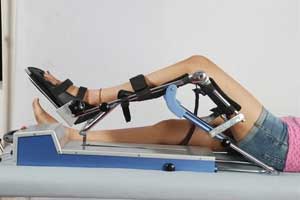- Home
- Editorial
- News
- Practice Guidelines
- Anesthesiology Guidelines
- Cancer Guidelines
- Cardiac Sciences Guidelines
- Critical Care Guidelines
- Dentistry Guidelines
- Dermatology Guidelines
- Diabetes and Endo Guidelines
- Diagnostics Guidelines
- ENT Guidelines
- Featured Practice Guidelines
- Gastroenterology Guidelines
- Geriatrics Guidelines
- Medicine Guidelines
- Nephrology Guidelines
- Neurosciences Guidelines
- Obs and Gynae Guidelines
- Ophthalmology Guidelines
- Orthopaedics Guidelines
- Paediatrics Guidelines
- Psychiatry Guidelines
- Pulmonology Guidelines
- Radiology Guidelines
- Surgery Guidelines
- Urology Guidelines
Continuous passive motion devices benefit in stiff shoulder,TKR

Training with motor-driven continuous passive motion (CPM) devices may prove to be beneficial in patients who have had knee or shoulder surgery or who require conservative treatment. However, this only applies to two therapeutic indications, and in each case only to one treatment outcome.
Patients with stiff shoulder have less pain with CPM treatment than with physiotherapy alone. As per the final report published by the Institute for Quality and Efficiency in Health Care (IQWiG), the range of motion after total knee replacement is improved if CPM is used in addition to physiotherapy. However, it is not of much benefit, for pain in rotator cuff tear, a condition involving the rupture of tendons in the shoulder.
Motor-driven CPM devices allow movement of the joints without the patients needing to use their muscles. With this method, intensive activation of the joints is possible already shortly after surgery. CPM is used to improve mobility, prevent stiffness and promote healing. It is usually not applied on its own, but as part of a multimodal therapy, supplementing physiotherapy.
Compared with the preliminary report, the researchers analyzed data from two additional studies. The results showed that CPM in addition to physiotherapy was effective after total knee replacement surgery. Data for 1693 patients were available for this therapeutic indication.
For rotator cuff tear, a condition involving the rupture of tendons in the shoulder requiring surgery, data from two studies with 155 participants in total compared CPM in combination with physiotherapy versus physiotherapy alone. In the preliminary report, this number was 100 but the study additionally analyzed had an opposing result for the outcome “pain”, so it was found not effective in rotator cuff tear.
Read Also: Liposomal bupivacaine not beneficial for pain management after knee surgery
Regarding the therapeutic indication of a stiff shoulder, however, there is still an indication of greater benefit of CPM. The assessment in the therapeutic indication of total knee replacement also remained the same with IQWiG indicating greater benefit. CPM used directly after surgery in addition to physiotherapy improves the patients’ ability to move their knees.
The report had certain limitations. Usable data on health-related quality of life and adverse events were still missing. IQWiG recommends conducting further randomized controlled trials (RCTs) in the therapeutic indications where currently no (greater) benefit can be determined.
According to the authors, these studies would be important to standardize both the administration of analgesics and the respective treatment regimens of CPM and physiotherapy and to provide detailed descriptions of their beginning and duration. Without this information, it is difficult to interpret the results.
For reference log on to https://www.iqwig.de/en/press/press-releases/continuous-passive-motion-for-knee-or-shoulder-joints-advantage-only-in-two-therapeutic-indications.9690.html

Disclaimer: This site is primarily intended for healthcare professionals. Any content/information on this website does not replace the advice of medical and/or health professionals and should not be construed as medical/diagnostic advice/endorsement or prescription. Use of this site is subject to our terms of use, privacy policy, advertisement policy. © 2020 Minerva Medical Treatment Pvt Ltd